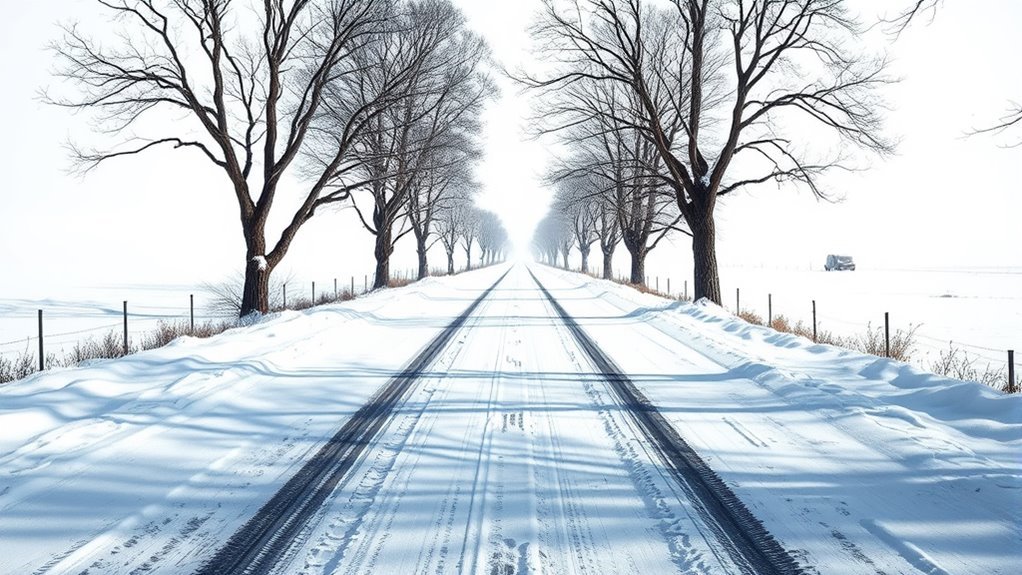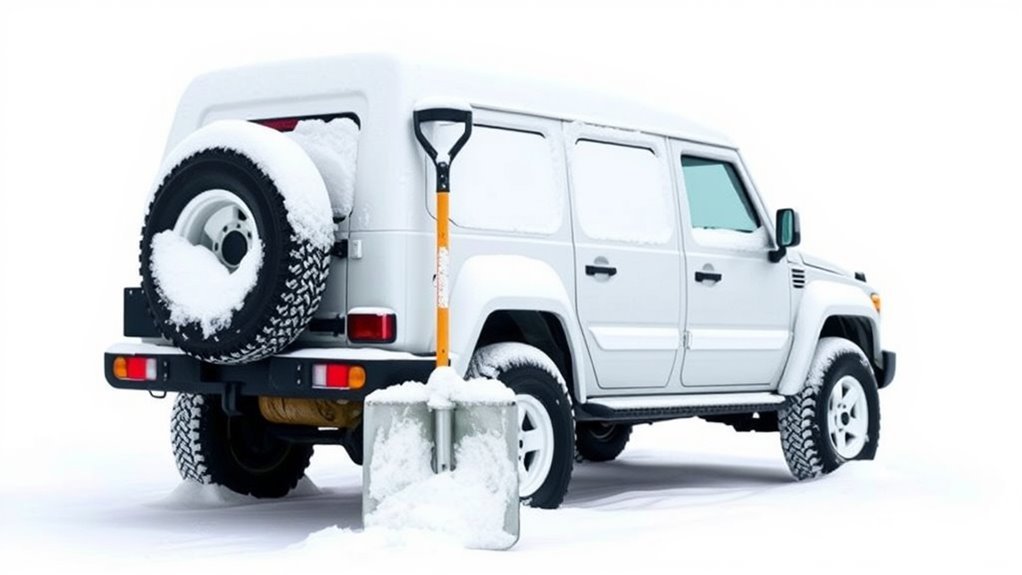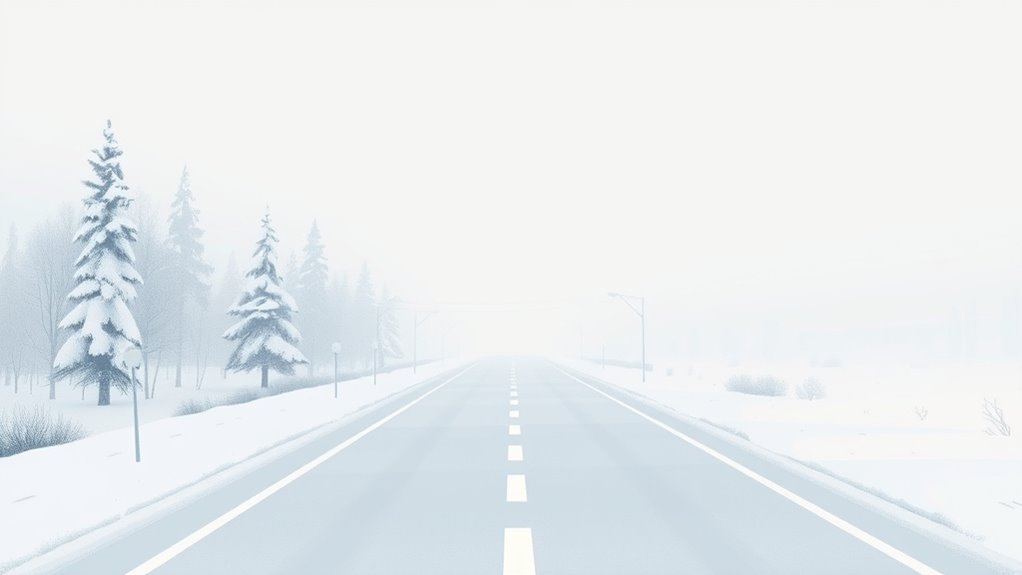Whiteout conditions during intense snow squalls pose severe risks for drivers. Sudden, heavy snowfall and strong winds diminish visibility to near zero, making navigation treacherous. Snow accumulation obscures road markings and can create slick, icy surfaces, increasing the chances of losing control or getting stuck. Hidden road hazards may lurk beneath the snow, complicating driving further. Staying informed about these dangers is essential for safety and effective winter driving. More perspectives on managing these conditions can be found.
Main Points
- Whiteout conditions occur during intense snow squalls, drastically reducing visibility to near zero, complicating navigation for drivers.
- Snow accumulation can obscure road markings and create slick surfaces, increasing the risk of losing control and accidents.
- Hidden hazards like potholes, debris, and black ice become more dangerous and difficult to detect in heavy snowfall.
- Drivers should reduce speed, maintain a greater following distance, and use headlights to enhance visibility during snow squalls.
- When caught in a snow squall, it is safest to pull over to a secure area and wait for conditions to improve.
Understanding Snow Squalls and Their Characteristics
What exactly defines a snow squall? A snow squall is marked by a sudden, intense burst of snowfall, often accompanied by strong winds. These weather events can lead to rapidly reduced visibility and notable accumulation over short periods.
Typically, snow squalls are brief, lasting anywhere from a few minutes to an hour, yet they can produce an impressive amount of snow, sometimes exceeding an inch or two in mere moments. The temperature during a snow squall may drop considerably, intensifying the impact on road conditions.
Snow squalls can occur with little warning, making them particularly hazardous for drivers. They often develop in the presence of a cold front or strong upper-level disturbances, leading to localized areas of heavy snowfall.
Recognizing the traits of snow squalls is essential for understanding their potential impact on travel and safety.
The Dangers of Whiteout Conditions
Snow squalls can rapidly lead to whiteout conditions, which pose considerable dangers for drivers. Visibility can decrease to near zero, making it nearly impossible to see road signs, other vehicles, or even the road itself. This disorientation can result in accidents, as drivers may be unaware of their speed or position on the roadway.
Additionally, the sudden onset of heavy snow can create a false sense of security, leading some drivers to underestimate the severity of the conditions. Moreover, the accumulation of snow on the road can lead to slick surfaces, increasing the risk of losing control.
In these extreme conditions, panic can set in, causing erratic driving behaviors, such as abrupt stops or dangerous maneuvers. Awareness of the dangers associated with whiteout conditions is essential for safety.
Drivers must prioritize caution and consider delaying travel until visibility improves greatly.
How Snow Accumulation Affects Driving
Snow accumulation considerably impacts driving conditions by reducing visibility and creating hazardous road surfaces.
As snow builds up, drivers encounter challenges in maintaining traction and control of their vehicles.
Understanding these effects is essential for safe navigation during winter weather.
Visibility Reduction Challenges
How does snow accumulation impact visibility on the road?
Snow accumulation greatly reduces visibility, creating hazardous driving conditions. As snow builds up, it obscures critical visual cues such as lane markings, road signs, and other vehicles.
Whiteout conditions can arise when heavy snowfall combines with wind, causing snow to swirl and further diminish sightlines. This lack of visibility can lead drivers to misjudge distances and speeds, increasing the risk of collisions.
Additionally, nighttime driving during snow accumulation exacerbates these challenges, as darkness amplifies the disorienting effects of falling snow. Drivers may struggle to gauge their surroundings, making it essential to reduce speed and increase caution in such conditions.
Ultimately, snow accumulation poses a serious threat to safe navigation on the road.
Traction and Control Issues
Driving on snow-covered roads presents considerable traction and control challenges. Snow accumulation can create a slick surface that reduces tire grip, making it difficult for vehicles to accelerate, decelerate, or steer effectively.
As snow compacts under traffic, it can form a layer of ice, further exacerbating these issues. Drivers may find themselves skidding or losing control, particularly during sharp turns or sudden stops.
The presence of deep snow can also hinder a vehicle's ability to maneuver, leading to stuck situations. Additionally, the effectiveness of braking systems diminishes in snowy conditions, increasing stopping distances appreciably.
To mitigate these hazards, drivers must modify their speed and techniques, prioritizing caution to maintain control in such treacherous environments.
Recognizing Road Hazards Hidden by Snow

In snowy conditions, drivers often face concealed road hazards that can lead to dangerous situations.
Common obstacles like potholes, fallen debris, and sharp turns may be obscured by snow accumulation, complicating navigation.
Coupled with visibility challenges, recognizing these hidden dangers becomes vital for maintaining safety on the road.
Common Hidden Hazards
As winter storms blanket roadways in snow, many hazards become obscured, posing considerable risks to unsuspecting drivers.
Potholes, which can form in the freeze-thaw cycle, may be hidden under fresh snow, leading to potential tire damage or loss of control. Additionally, road edges can become indistinguishable from the surrounding terrain, increasing the likelihood of vehicles veering off-course.
Hidden ice patches, often referred to as "black ice," can be particularly treacherous, as they appear transparent and blend with the road surface. Snow-covered debris, such as fallen branches or other obstacles, may also pose threats.
Drivers must remain vigilant, reducing speed and maintaining a safe distance, to steer through these concealed dangers and guarantee their safety during intense snow squalls.
Visibility Challenges
Snowstorms can markedly impair visibility, compounding the dangers posed by hidden road hazards. Drivers may struggle to perceive lane markings, traffic signs, or even the edges of the roadway, leading to disorientation.
Snow can obscure essential features such as potholes, debris, or even stopped vehicles, increasing the risk of accidents. Furthermore, the swirling nature of falling snow can create whiteout conditions, where the horizon blurs and depth perception diminishes.
These factors can mislead even experienced drivers, leading to sudden braking or erratic maneuvers. Consequently, the inability to identify these hazards calls for heightened caution and slower speeds.
Awareness of the limitations imposed by reduced visibility is vital for maintaining safety during such treacherous weather conditions, eventually helping to prevent collisions and injuries.
Snow Accumulation Effects
Although snow accumulation can create a picturesque winter scenery, it also conceals numerous road hazards that pose considerable risks to drivers. Beneath a thick layer of snow, potholes, curbs, and even abandoned vehicles can become nearly invisible, leading to potential accidents.
Additionally, accumulated snow can mask icy patches, which may cause vehicles to lose traction unexpectedly. Moreover, snowdrifts along road edges can obstruct visibility, making it difficult for drivers to gauge the road's boundaries.
The weight of snow can also lead to falling branches or damage to roadside infrastructure, adding another layer of danger. Consequently, understanding the hidden threats posed by snow accumulation is essential for safe navigation during winter weather conditions.
Preparing Your Vehicle for Winter Driving

Before commencing winter journeys, drivers must verify their vehicles are properly prepared to handle the unique challenges posed by icy roads and severe weather.
A thorough vehicle inspection is vital to guarantee safety and maximize performance in winter conditions.
Key preparations include:
- Winter Tires: Installing high-quality winter tires improves traction and stability on snow and ice.
- Battery Check: Cold temperatures can diminish battery performance, so confirming that the battery is fully charged and in good condition is essential.
- Antifreeze Levels: Maintaining appropriate antifreeze levels prevents the engine from freezing and supports peak vehicle operation.
- Emergency Kit: Equipping the vehicle with an emergency kit, including blankets, non-perishable food, and a flashlight, can provide significant support in case of unforeseen situations.
Tips for Safe Driving in Snow Squalls
Driving in snow squalls presents unique challenges that require heightened awareness and flexibility. Drivers should reduce their speed considerably, as even a slight increase can lead to loss of control on slick roads.
Maintaining a greater following distance is vital, allowing more time to react to sudden stops or changes in traffic. Using headlights in snow squall conditions improves visibility for both the driver and other vehicles.
Drivers should avoid abrupt maneuvers, such as sharp turns or sudden braking, which can instigate skidding. It is also advisable to stay in the right lane, enabling easier navigation and potential escape routes if visibility worsens.
Finally, drivers must be prepared for rapidly changing conditions; if visibility drops to near zero, finding a safe area to pull over until conditions improve is essential.
What to Do If You Get Caught in a Snow Squall
When a driver finds themselves caught in a snow squall, staying calm and focused is essential to guarantee safety. The sudden onset of heavy snowfall can create treacherous conditions, making visibility nearly impossible.
It is important for drivers to take immediate action to protect themselves and others on the road.
- Reduce speed and maintain a safe distance from the vehicle ahead to prevent skidding.
- Turn on hazard lights to increase visibility to other drivers.
- Find a safe place to pull over, such as a parking lot or broad shoulder, away from traffic.
- Remain in the vehicle until conditions improve, as it provides shelter from the elements.
Following these steps can help mitigate risks during a snow squall, allowing drivers to handle the situation with greater assurance and safety.
Common Questions
How Can I Report Dangerous Road Conditions During a Snow Squall?
Reporting dangerous road conditions during a snow squall is essential for safety. Individuals can contact local authorities, use designated hotlines, or report through community apps to guarantee timely warnings and information dissemination for others on the road.
Are Snow Squalls More Common in Certain Regions?
Snow squalls occur more frequently in certain regions, particularly those with colder climates and geographical features conducive to rapid temperature changes. Areas near the Great Lakes and Appalachian Mountains often experience these intense weather phenomena.
What Should I Wear When Driving in Snow Squalls?
When driving in snow squalls, individuals should wear warm, layered clothing, including insulated jackets, waterproof boots, and gloves. Additionally, they should guarantee visibility with hats and scarves while maintaining comfort and mobility inside the vehicle.
How Can I Help Others Stranded in Snow Squalls?
To assist others stranded in difficult weather, one should guarantee safety first, provide warm blankets, share food and water, and call for emergency services if necessary, while maintaining clear communication and offering reassurance throughout the ordeal.
Can Snow Squalls Happen in Warmer Temperatures?
Snow squalls typically occur in colder temperatures, as they require specific atmospheric conditions. Nevertheless, unexpected shifts in weather patterns may occasionally lead to squall-like phenomena in warmer climates, though these instances are rare and less intense.

